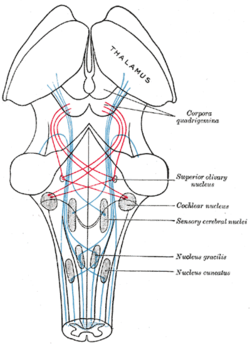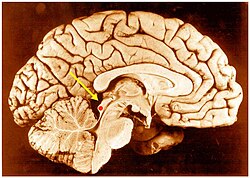The interaural time difference (or ITD) when concerning humans or animals, is the difference in arrival time of a sound between two ears. It is important...
17 KB (2,577 words) - 03:18, 7 December 2024
Sound localization (redirect from Interaural intensity difference)
are time difference and intensity difference between the sound signals of two ears. We call those kinds of differences as Interaural Time Difference (ITD)...
47 KB (6,472 words) - 08:52, 25 May 2025
Acoustic location (section Time difference of arrival)
the interaural time difference. The interaural time difference is the difference in arrival time of a sound between two ears. The interaural time difference...
19 KB (2,236 words) - 16:08, 14 March 2025
This difference in distance causes a slight delay in the time the signal is perceived by each ear. The magnitude of the interaural time difference is greater...
31 KB (3,952 words) - 19:44, 26 October 2024
when there is a difference between the interaural phase of the signal and the interaural phase of the noise. When such a difference is present there...
11 KB (1,459 words) - 03:05, 15 August 2023
auditory nerve. They are then able to use interaural time difference (ITD) and interaural level difference (ILD) to pinpoint the location and elevation...
28 KB (4,335 words) - 00:42, 21 February 2025
by the difference in hearing between the left and right ears. These differences include the interaural time difference (ITD) and the interaural intensity...
29 KB (4,250 words) - 04:13, 3 April 2025
retinotopic map, or that time codes are used in organization as in the maps of an owl's sense of direction via interaural time difference between ears. These...
16 KB (2,379 words) - 12:08, 24 May 2025
naturally as a person listens, generating interaural time differences (ITDs) and interaural level differences (ILDs) specific to their listening position...
29 KB (3,687 words) - 00:07, 24 May 2025
Time-of-flight, time for a particle to travel through a medium Interaural time difference, difference in time that it takes a sound to travel between two ears Travel...
921 bytes (167 words) - 13:51, 25 March 2021
cone of confusion, a series of points where interaural time difference (ITD) and interaural level difference (ILD) are identical for sound sources from...
25 KB (3,365 words) - 08:47, 19 April 2025
including the interaural time difference (ITD, the difference in arrival time of a sound between two locations), the interaural intensity difference (IID, the...
14 KB (1,830 words) - 21:43, 26 February 2025
side is heard approximately 0.0003 seconds later. This is the interaural time difference (ITD) cue and is measured by signal processing in the two central...
22 KB (3,037 words) - 16:41, 3 June 2025
ways the brain detects a direction of a sound: Interaural level difference, interaural time difference and head-related transfer function. The worst installations...
31 KB (4,029 words) - 14:52, 25 May 2025
contributed to the theory of binaural hearing, propose the theory of interaural time difference as the main cue, and developing sound localization devices (for...
8 KB (951 words) - 21:33, 14 June 2025
from one channel to the other, delaying the signal to mimic interaural time differences and applying other characteristics of head-related transfer functions...
3 KB (395 words) - 20:29, 30 October 2024
important in detecting interaural level differences while the latter is important in distinguishing interaural time difference. The lateral lemniscus...
37 KB (4,397 words) - 17:50, 23 December 2024
that is believed to measure the time difference of arrival of sounds between the ears (the interaural time difference or ITD). The ITD is a major cue...
27 KB (3,228 words) - 23:03, 6 March 2025
equals the human ear distance and therefore provides the same interaural time difference (ITD) or more, depending on the spacing between microphones. Although...
88 KB (11,154 words) - 01:39, 25 May 2025
; Bailey, Peter J. (2000). "Auditory spatial attention using interaural time differences". Journal of Experimental Psychology: Human Perception and Performance...
7 KB (717 words) - 01:05, 3 June 2025
energy, was not measured or compared. Skottun et al. measured the interaural time difference sensitivity of single neurons in the inferior colliculus, and...
9 KB (1,107 words) - 13:41, 16 October 2024
reach the ears at different times. This is referred to as the interaural time difference (ITD). Due to differing lengths and a finite conduction speed...
15 KB (1,814 words) - 18:07, 22 November 2024
sounds using the interaural time difference (ITD) and the interaural level difference (ILD). The ITD is the difference in the time it takes sound to...
12 KB (1,384 words) - 04:08, 25 November 2024
by analyzing interaural time difference (ITD). Localization of high-frequency sounds is aided by analyzing interaural level difference (ILD) and spectral...
17 KB (2,023 words) - 18:03, 26 September 2024
feature of Aspect-oriented computer programming. Interaural time difference, the difference in arrival time of a sound between two ears Internal tandem duplication...
843 bytes (121 words) - 14:55, 14 May 2025
order to compute the location of a sound source in space from interaural time differences, an auditory system relies on delay lines: the induced signal...
25 KB (3,349 words) - 23:29, 12 June 2024
an interaural time difference, ITD), and will also be louder at the near ear (creating an interaural level difference, ILD – also known as interaural intensity...
4 KB (612 words) - 05:16, 3 February 2023
Ambisonics (category All articles with vague or ambiguous time)
this range, which causes a slight difference in level between the ears. This is called the interaural level difference, or ILD (the same cone of confusion...
50 KB (6,064 words) - 16:30, 29 April 2025
what degree the recording has captured the interaural level differences (ILD) and the interaural time differences (ITD) that characterize two-eared human...
11 KB (1,480 words) - 03:04, 24 August 2022
used by the barn owl to localize sound are interaural time difference (ITD) and interaural intensity difference (IID). The owl’s ears are asymmetric, with...
14 KB (1,956 words) - 01:56, 18 November 2024









